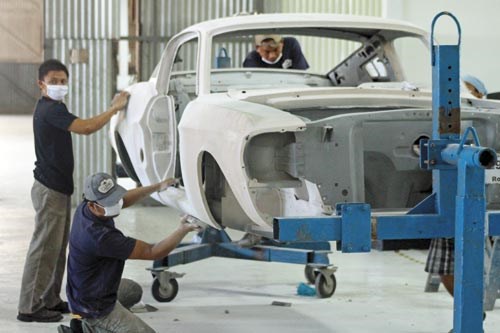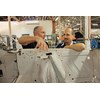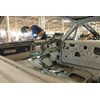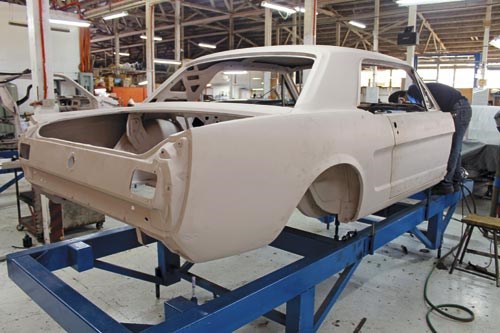Project Mustang update: Nearing paint
 Project Mustang update: paint
Project Mustang update: paint

 Project Mustang update: paint
Project Mustang update: paint

 Project Mustang update: paint
Project Mustang update: paint

 Project Mustang update: paint
Project Mustang update: paint


|
|
Project Mustang update: paint
|

|
|
Project Mustang update: paint
|

|
|
Project Mustang update: paint
|

|
|
Project Mustang update: paint
|
2000 hours of work and the Classic Speed Mustang is nearing the paint booth

|
|
Project Mustang update: paint
|
Project Mustang
Our lovely D-Code Project Mustang is taking shape, now that some major decisions have been made on exactly what the final package should look like. Last issue we covered off the basics for the powerplant and transmission, while the issue before we gave you a bit of an overview on sourcing the car and what it needed.
What we didn’t get to, though, was just how much effort is really going into this thing. Try 2000 man-hours before it even sees the paint booth. Yep, that’s a two followed by three zeros!
It’s hard to get your head around it, but this is restoration at a whole other, higher level. And to be blunt, you could not do it in this country – the cost would be way beyond prohibitive. It would be insane.
At Classic Speed in the Philippines, the car spends about half its restoration journey in ‘denting’ – or basic panel works – before it’s even allowed to move on. The process sounds simple enough at first but is far more complicated and labour intensive.
"[First] we cut and strip anything that’s not useable from the car, which can be quite a bit," says factory manager Richard Dearing. "Then it goes into sandblasting and then we start replacing the panels."
And here’s the key part to the quality of the chassis coming out of Classic Speed: "We set them up on our own design jig," Richard adds.
Say what? Not happy with struggling to get perfectly good parts bent and shaped to fit 50-year-old cars, the Classic Speed crew decided they needed to look at the basics, like, is it actually possible to build a straight-as-a-dye Mustang?
It is, if you are prepared to forget the restrictions of mass-production and get into bespoke work from the start.
"We built these jigs because even from Ford these cars could be at least a quarter or three-eighths of an inch off in different places from brand new. No car was exactly the same," reveals Richard.
"We’ve made these jigs so they tie in at specific points on the car: the forward leaf spring mounts at the rear, and the actual mounting points of the upper control arms.
"So we know when we start putting on quarter panels, doors and front fenders that every gap will be right and every car will be the same." General manager Haydn Baldwin chimes in: "We’ve got cars that are 50 years old and parts that come from all over the world. So if, for example, you’ve got a GT350 and you’re ordering a new panel from overseas, you’ll spend the next flaming week trying to get the thing to align properly.
"I cannot think of a single company in the world that has purpose-built jigs for 1965-’70 Mustangs. We made them ourselves," says Haydn, with a hint of pride in his voice.
"We do the dash conversion, and we’re now set up to make our own right-hand-drive instrument panel bezels," Richard continues. "There’s an awful lot of work done right there in denting even before it goes into body works. Once the panels are installed, we hand-beat the flares for the guards and they’re all done in metal."
Even at that stage, the job is far from over. While the theory of a straight body sounds fine, the crew insists on testing it.
"We put used window glass in at that time to make sure everything works correctly," explains Richard. "The doors are aligned with gaskets and sill plates to make sure all the doors are aligned and close properly. It’s all quality-controlled by me before it leaves that section."
You get the distinct impression this might be bordering on obsessive, though Richard and Haydn seem normal enough, for two petrol-heads. Why go to all this trouble?
"Generally our clients are next-level guys," says Haydn. He explains that they’re way beyond the point where a car out of the classifieds is enough to satisfy their lust for nirvana on wheels.
At the palatial Unique Cars offices, we are looking for a good, tough and reliable restoration that could tackle club events but be just as comfortable as a daily driver. So far, it looks like we’re getting more than we bargained for…
Unique Cars magazine Value Guides
Sell your car for free right here
Get your monthly fix of news, reviews and stories on the greatest cars and minds in the automotive world.
Subscribe

.jpg)










